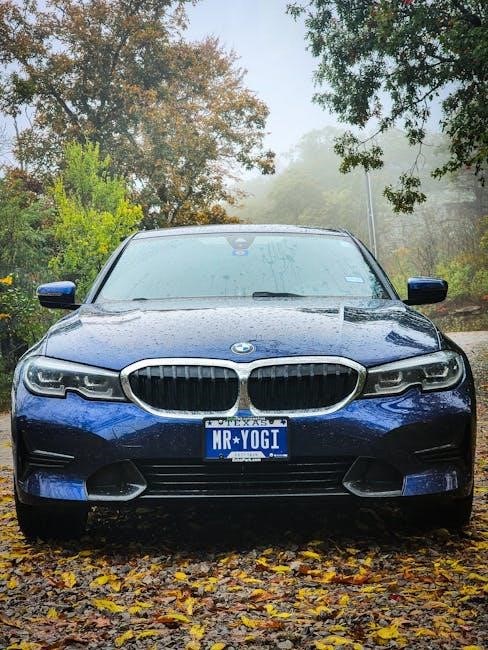This comprehensive guide provides essential resources and strategies to help you prepare for the Illinois driving test, covering road rules, signs, and safe driving practices effectively.
1.1 Overview of the Illinois Driving Test
The Illinois driving test is designed to ensure applicants demonstrate a thorough understanding of traffic laws, road signs, and safe driving practices. The test consists of three main components: a written knowledge test, a vision test, and a road driving test. The written test includes 35 questions covering road rules, signs, and safety topics, requiring at least 28 correct answers to pass. The vision test assesses visual acuity, while the road test evaluates driving skills and adherence to traffic laws. The Illinois Rules of the Road manual serves as the primary study resource, providing detailed information on all test topics. Proper preparation is crucial, as the test is structured to reflect real-world driving scenarios and legal requirements. By studying the manual and practicing with online resources, applicants can confidently navigate the exam and obtain their driving privileges.

1;2 Importance of Proper Preparation
Proper preparation is crucial for success on the Illinois driving test. Understanding traffic laws, road signs, and safe driving practices ensures confidence and competence behind the wheel. The official Illinois Rules of the Road manual is a key resource, providing detailed information on test topics. Utilizing practice tests and study guides helps familiarize applicants with the exam format and content. Adequate preparation reduces test anxiety and minimizes the likelihood of errors. It also ensures that drivers are well-equipped to handle real-world scenarios, promoting road safety. Investing time in studying and practicing guarantees a higher chance of passing the test on the first attempt and becoming a responsible driver.

Illinois Rules of the Road
This section covers Illinois traffic laws, road signs, and safe driving practices, ensuring a thorough understanding of the rules essential for safe and legal driving in Illinois.
2.1 Traffic Laws and Regulations
Understanding Illinois traffic laws is crucial for safe and legal driving. Key regulations include speed limits, right-of-way rules, and restrictions on cellphone use for drivers under 20. Teen drivers must follow specific guidelines, such as limiting passengers under 20 during the initial licensing phase. Additionally, Illinois enforces strict penalties for violations like reckless driving and speeding in school zones. Familiarizing yourself with these laws ensures compliance and reduces risks on the road. The official Illinois Rules of the Road manual provides detailed information on traffic laws, helping drivers prepare for the written test and maintain safe driving habits. Practice tests and study guides are excellent resources to reinforce knowledge of these regulations.
2.2 Road Signs Recognition
Recognizing road signs is a fundamental aspect of safe driving in Illinois. The state uses various signs, including traffic control, warning, and guide signs, to ensure driver awareness and compliance. Traffic control signs, such as stop signs and traffic signals, dictate vehicle movement. Warning signs alert drivers to potential hazards, like curves or pedestrian crossings. Guide signs provide directional information, helping drivers navigate roads effectively. Studying these signs is essential for passing the written test and maintaining road safety. The Illinois Rules of the Road manual and online resources like Quizlet offer detailed flashcards and practice tests to help master road sign recognition. Regular practice ensures quick identification and appropriate responses to signs while driving.
2.3 Safe Driving Practices
Safe driving practices are crucial for minimizing risks on Illinois roads. Key practices include maintaining a safe speed, following distance, and using seatbelts. Speed limits vary by zone, and drivers must adjust accordingly. Following distance ensures time to react to sudden stops. Seatbelt use is mandatory for all occupants. Additionally, Illinois prohibits texting and handheld phone use while driving, with exceptions for emergencies. Drivers under 20 are banned from using cellphones entirely. Defensive driving techniques, such as anticipating others’ actions, are highly recommended. Staying alert, avoiding distractions, and respecting traffic laws are essential for safe driving. These practices not only prevent accidents but also help drivers pass the road test and maintain a clean record.
Types of Illinois Driving Tests
The Illinois driving tests include a written knowledge test, a vision test, and a road driving test. Each evaluates different skills to ensure safe and competent driving abilities.
3.1 Written Knowledge Test
The written knowledge test is a critical component of the Illinois driving exam, assessing understanding of road rules, traffic signs, and safe driving practices. It consists of 35 multiple-choice questions, with a passing score of 28. Topics include traffic laws, road signs, and distracted driving. The Illinois Rules of the Road manual serves as the primary study resource. Practice tests and Quizlet flashcards are highly recommended to familiarize yourself with the format and content. The test is available in multiple languages, including English, Spanish, Hindi, and Vietnamese. Accurate preparation is essential, as the questions are directly based on the official manual. Utilizing study aids like DMV cheat sheets can enhance your readiness and confidence for the exam.
3.2 Vision Test
The vision test is a standard requirement for obtaining a driver’s license in Illinois, ensuring applicants can safely operate a vehicle. It assesses visual acuity, color vision, and peripheral vision. Applicants must meet the minimum visual acuity standard of 20/40 in both eyes, with or without corrective lenses. If corrective lenses are needed, the restriction will be noted on the license. The test is straightforward, involving reading an eye chart and identifying colors. Failure to meet the vision requirements may require a professional evaluation. This test is crucial for determining a driver’s ability to navigate safely and react to road conditions. Proper vision ensures clarity and awareness while driving, making it a vital part of the licensing process.
3.3 Road Driving Test
The road driving test evaluates your ability to safely operate a vehicle in real-world conditions. It is conducted by a certified examiner who assesses your driving skills, adherence to traffic laws, and vehicle control. During the test, you will be required to demonstrate various maneuvers, such as turning, stopping, merging, and parking. The examiner will also observe your ability to navigate intersections, follow traffic signals, and maintain safe distances. The test is typically conducted in a personal vehicle, which must be properly insured and registered. Familiarity with the vehicle’s controls is essential for a smooth performance. The examiner will score your test based on accuracy, safety, and overall driving proficiency. Passing this test is a critical step toward obtaining your Illinois driver’s license.
Eligibility and Requirements
Understand the eligibility criteria and requirements for obtaining an Illinois driver’s license, including age restrictions, necessary documents, and fees to ensure a smooth application process.
4;1 Age Requirements for Drivers
In Illinois, the age requirements for obtaining a driver’s license vary based on driver type. Teens under 18 must complete 50 hours of supervised driving, with restrictions during the first year of licensing. Drivers under 20 are prohibited from using cellphones except in emergencies. For seniors, a new bill proposes raising the age for mandatory driving tests from 79 to 87, aligning Illinois with other states. This change aims to reduce barriers for older drivers while maintaining road safety. Understanding these age-specific rules is crucial for applicants to navigate the licensing process smoothly and meet all eligibility criteria effectively.
4;2 Required Documents for Application
Applicants for an Illinois driver’s license must provide specific documents to verify identity, residency, and legal status. These include a valid birth certificate, Social Security card, and two proofs of residency, such as utility bills or bank statements. For minors, a parent or guardian’s signature is required on the application. Additional documentation may be needed for name changes or immigration status. It’s essential to ensure all documents are up-to-date and meet the Secretary of State’s requirements. Gathering these materials beforehand streamlines the application process and avoids delays. For the most accurate and updated list, refer to the official Illinois DMV website or consult the Illinois Rules of the Road manual.

4.3 Fees and Payment Methods

The cost of obtaining a driver’s license in Illinois varies based on the type and duration. A standard driver’s license typically costs $30, while a REAL ID-compliant license may incur an additional $5 fee. Payment methods accepted by the Illinois Secretary of State’s office include cash, credit cards, checks, and money orders. Some facilities may also accept mobile payments. Senior drivers aged 65 and older are eligible for a free, non-expiring license. It’s important to verify the exact fee structure and payment options before visiting a Driver Services facility, as these details are subject to change. For the most accurate information, refer to the official Illinois DMV website or consult the Illinois Rules of the Road manual.

Study Resources and Materials
The Illinois Rules of the Road manual, practice tests, and DMV cheat sheets are essential tools for preparing for the driving test, ensuring comprehensive knowledge of state driving laws.
5.1 Official Illinois Rules of the Road Manual
The Official Illinois Rules of the Road Manual is the primary resource for preparing for the Illinois driving test. Published by the Illinois Secretary of State, this manual provides detailed information on traffic laws, road signs, and safe driving practices. It is divided into clear sections, covering topics such as speed limits, right-of-way rules, and alcohol-awareness programs. The manual also includes illustrations of road signs and examples of common driving scenarios. As the official guide, it aligns perfectly with the content of the written knowledge test, making it an indispensable study tool. Available in both PDF and hard copy formats, the manual ensures accessibility for all learners. By thoroughly studying this guide, applicants can gain a deep understanding of Illinois driving laws and regulations, significantly improving their chances of passing the test with confidence.
5.2 Practice Tests and Quizlets
Practice tests and Quizlets are invaluable tools for preparing for the Illinois driving test. These resources provide realistic simulations of the actual exam, helping you assess your knowledge and identify areas for improvement. Many practice tests include multiple-choice questions that mirror the format and content of the official test, covering topics such as road signs, traffic laws, and safe driving practices. Quizlets, in particular, offer interactive flashcards and study games that make learning engaging and effective. By regularly using these tools, you can build confidence, reduce test anxiety, and ensure a thorough understanding of Illinois driving regulations. Utilizing practice tests and Quizlets complements your study of the official manual, providing a well-rounded approach to exam preparation.

5.3 DMV Cheat Sheets and Study Guides
DMV cheat sheets and study guides are designed to simplify your preparation for the Illinois driving test. These concise resources summarize key topics, such as road signs, traffic laws, and safe driving practices, ensuring you focus on essential information. Many cheat sheets include hints and 50/50 tools to help you navigate challenging questions. Updated for 2025, they reflect the latest Illinois driving regulations and test formats. These guides are particularly useful for quick reviews and last-minute preparation. By leveraging DMV cheat sheets, you can reinforce your knowledge and approach the test with confidence. They complement practice tests and the official manual, offering a streamlined path to success.

Test Preparation Strategies

Effective study habits, regular practice driving, and utilizing cheat sheets can significantly improve your readiness for the Illinois driving test, ensuring confidence and success.
6.1 Effective Study Tips for Success
Mastering the Illinois driving test requires a structured approach. Start by thoroughly studying the Illinois Rules of the Road Manual, focusing on traffic laws, road signs, and safe driving practices. Break your study sessions into manageable parts, prioritizing key areas like road signs and traffic violations. Utilize online resources such as practice tests and Quizlet flashcards to reinforce your knowledge. Regularly review and understand common mistakes to avoid them during the actual test. Simulate test conditions by timing yourself and answering questions without hints. Consistent practice and a focused mindset will significantly improve your confidence and readiness to pass the Illinois driving test successfully.

6.2 Importance of Practice Driving
Practice driving is crucial for mastering the skills needed to pass the Illinois driving test. Regular behind-the-wheel practice helps you apply the knowledge gained from study materials to real-world scenarios. Focus on improving your ability to handle various driving conditions, such as urban traffic, highways, and intersections. Practice essential maneuvers like parallel parking, three-point turns, and merging lanes. For teen drivers, Illinois requires at least 50 hours of supervised driving, including nighttime practice. Seniors should also refresh their skills to maintain confidence and safety on the road. Consistent practice ensures familiarity with vehicle controls and builds the muscle memory necessary for smooth, safe driving. Regular practice sessions are key to achieving success in both the written and road driving tests.
6.3 Understanding Common Mistakes
Identifying and addressing common mistakes is vital for success on the Illinois driving test. Many applicants fail due to errors like failing to check blind spots, improper lane changes, or speeding. Other frequent issues include inadequate signaling, rolling stops at stop signs, and poor parking techniques. For teen drivers, distractions like cell phone use or carrying too many passengers can lead to mistakes. Seniors may struggle with reaction times or understanding new traffic laws. Recognizing these pitfalls allows you to focus on improvement during practice. Reviewing the Illinois Rules of the Road and seeking feedback from instructors can help you avoid these errors. By addressing these common mistakes, you can build confidence and increase your chances of passing the test on the first try.
Special Considerations
Teen drivers under 18 must complete 50 hours of supervised driving, while seniors over 65 face annual tests; New laws aim to ease restrictions for older drivers starting at 87.
7.1 Teen Drivers (Under 18)
Teen drivers in Illinois under 18 must meet specific requirements to obtain their driver’s license. They are required to complete a minimum of 50 hours of supervised behind-the-wheel driving, including 10 hours at night. During the initial licensing phase, teens are allowed only two passengers under age 20 unless accompanied by a parent or legal guardian. Additionally, drivers under 20 are prohibited from using cellphones while driving, except in emergencies. The state also mandates traffic safety education for teens, focusing on road rules, safe driving practices, and the consequences of reckless behavior. These restrictions aim to reduce accidents and ensure young drivers gain sufficient experience before obtaining full driving privileges.
7.2 Senior Drivers (65+)
Senior drivers in Illinois aged 65 and above face specific requirements to maintain their driving privileges. A new bill aims to raise the age for mandatory behind-the-wheel driving tests from 79 to 87, reducing barriers for older drivers. This legislation, drafted by Secretary of State Alexi Giannoulias, aligns Illinois with other states and reflects the low crash rate among senior drivers. The bill, unanimously approved by the Senate, is designed to ensure safe driving while respecting the independence of older adults. Seniors will still need to renew their licenses, but the behind-the-wheel test will no longer be required until age 87, unless specific concerns arise. This change supports aging drivers while prioritizing road safety.
In conclusion, the Illinois State Driving Test Study Guide is an invaluable resource for all drivers seeking to obtain or renew their license. By focusing on the official Illinois Rules of the Road manual, practice tests, and essential study materials, this guide ensures a comprehensive understanding of traffic laws, road signs, and safe driving practices. Whether you’re a teen driver, a senior, or an experienced motorist, this guide provides tailored insights and strategies to help you prepare effectively. With updated information on recent changes, such as the age adjustment for senior driving tests, this guide equips you with the knowledge and confidence to pass your test and stay safe on the road. Continuous learning and adherence to Illinois driving laws are key to becoming a responsible and skilled driver.




About the author